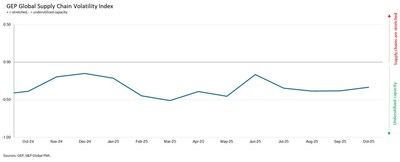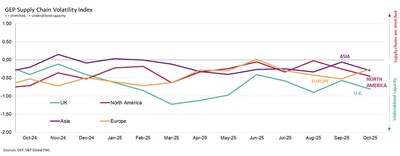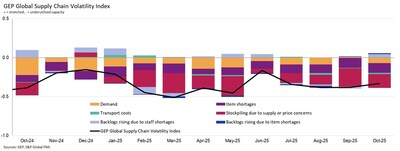NORTH AMERICAN MANUFACTURERS CUT ORDERS AS GLOBAL SUPPLY CHAINS REMAIN UNDERUTILIZED IN OCTOBER: GEP GLOBAL SUPPLY CHAIN VOLATILITY INDEX
GEP Global Supply Chain Volatility Index (SPGI) reported global supply chains remained underutilized in October 2025, with the headline index at -0.33, signaling spare capacity and limited price pressure beyond tariffs. North America showed the steepest pullback in input purchases (-0.45 in October vs. -0.25), pointing to weaker factory production into winter. Asia cooled as China reduced buying (index -0.30), while Europe saw only a marginal recovery (-0.25). Inventories remain lean, material shortages are below trend, transportation costs eased slightly, and labor-related backlogs rose modestly.
GEP Global Supply Chain Volatility Index (SPGI) ha rilevato che le catene di approvvigionamento globali sono rimaste sottoutilizzate nell'ottobre 2025, con l'indice principale a -0.33, indicando capacità inutilizzata e una pressione sui prezzi limitata al di là delle tariffe. L'America settentrionale ha mostrato il calo più marcato degli acquisti di input (-0.45 in ottobre rispetto a -0.25), suggerendo una minore produzione industriale verso l'inverno. L'Asia si è raffreddata poiché la Cina ha ridotto gli acquisti (indice -0.30), mentre l'Europa ha visto solo una lieve ripresa (-0.25). Le scorte rimangono scarse, le carenze di materiali sono al di sotto della tendenza, i costi di trasporto sono lievemente diminuiti e gli arretrati legati al lavoro sono aumentati in modo modesto.
GEP Global Supply Chain Volatility Index (SPGI) informó que las cadenas de suministro globales siguieron subutilizadas en octubre de 2025, con el índice principal en -0.33, lo que indica capacidad ociosa y una presión de precios limitada más allá de los aranceles. Norteamérica mostró la mayor caída en las compras de insumos (-0.45 en octubre frente a -0.25), apuntando a una menor producción fabril hacia el invierno. Asia se enfrió a medida que China redujo las compras (índice -0.30), mientras que Europa vio apenas una recuperación marginal (-0.25). Los inventarios siguen ajustados, las escaseces de materiales están por debajo de la tendencia, los costos de transporte han disminuido ligeramente y los pedidos atrasados relacionados con el trabajo aumentaron moderadamente.
GEP Global Supply Chain Volatility Index (SPGI)는 2025년 10월 글로벌 공급망이 여전히 비활용 상태였다고 보고했으며, 주요 지수는 -0.33로 나타나 여유 인력과 관세를 넘어서는 가격 압력이 제한적임을 시사합니다. 북미는 원자재 구매 감소폭이 가장 컸으며 (-0.45 in October vs. -0.25), 겨울철 공장 생산이 약화될 것을 가리킵니다. 아시아는 중국의 구매 감소로 냉각되었고 (지수 -0.30), 유럽은 미미한 회복에 그쳤습니다 (-0.25). 재고는 여전히 부족하고 자재 부족은 트렌드 아래에 있으며 운송비는 약간 낮아졌고 노동 관련 병목 현상은 다소 증가했습니다.
GEP Global Supply Chain Volatility Index (SPGI) a indiqué que les chaînes d'approvisionnement mondiales restent sous-utilisées en octobre 2025, avec l'indice principal à -0,33, ce qui signale une capacité inutilisée et une pression sur les prix limitée au-delà des droits de douane. L'Amérique du Nord a enregistré la plus forte contraction des achats d'intrants (-0,45 en octobre contre -0,25), ce qui suggère une production industrielle plus faible à l'approche de l'hiver. L'Asie s'est refroidie alors que la Chine réduisait ses achats (indice -0,30), tandis que l'Europe a connu une reprise marginale (-0,25). Les inventaires restent serrés, les pénuries de matériaux sont en dessous de la tendance, les coûts de transport ont légèrement diminué et les retards liés à la main-d'œuvre ont augmenté Modérément.
GEP Global Supply Chain Volatility Index (SPGI) berichtete, dass globale Lieferketten im Oktober 2025 weiterhin unterausgelastet waren, wobei der Hauptindex bei -0,33 lag, was ungenutzte Kapazität und einen begrenzten Preisdruck jenseits von Zöllen signalisiert. Nordamerika verzeichnete den stärksten Rückgang der Anschaffungen von Vorleistungen (-0,45 im Oktober gegenüber -0,25), was auf eine schwächere Fabrikproduktion in den Winter hindeutet. Asien kühlte ab, da China die Käufe reduzierte (Index -0,30), während Europa nur eine marginale Erholung sah (-0,25). Lagerbestände bleiben knapp, Materialknappheiten liegen unter dem Trend, Transportkosten sanken leicht, und arbeitsbedingte Rückstände stiegen moderat.
GEP Global Supply Chain Volatility Index (SPGI) أظهر أن سلاسل التوريد العالمية بقيت غير مستغلة في أكتوبر 2025، مع قراءة العنوان عند -0.33, مما يدل على وجود طاقة احتياطية وضغوط الأسعار محدودة خارج الرسوم الجمركية. شهدت أمريكا الشمالية أكبر تراجع في شراء المدخلات (-0.45 في أكتوبر مقابل -0.25)، مما يشير إلى انخفاض في إنتاج المصانع نحو الشتاء. آسيا تراجعت مع تقليل الصين للمشتريات (المؤشر -0.30)، بينما شهدت أوروبا تعافياً هامشياً فقط (-0.25). تظل المخزونات محدودة، ونقص المواد دون الاتجاه، وتكاليف النقل انخفضت قليلاً، وتزايدت الاختناقات المرتبطة بالعمالة بشكل متوسط.
- Headline volatility index at -0.33 signals spare global capacity
- Inventories remain lean, limiting price-driven stockpiling
- Transportation costs ticked down to below-average levels
- North America index fell to -0.45, steepest drop since May
- Asia index dropped to -0.30 driven by weaker Chinese buying
- U.K. index plunged to -0.80, indicating sharp supplier slowdown
- Ample global spare capacity lowers risk of goods price inflation beyond tariffs as manufacturers trim inventories and purchasing
- North American manufacturers report steepest drop in material purchases since May, signaling weaker production ahead
-
Chinese factories pull back buying, increasing spare capacity across
Asia's suppliers -
Europe's manufacturing sector recovery continues to make slow progress
The Volatility Index, which tracks demand conditions, shortages, transportation costs, inventories, and backlogs, registered –0.33 in October, indicating that global supply chain capacity remains underused. Manufacturers across major economies continued to keep inventories lean and curb new purchases of inputs.
In
In
"
OCTOBER 2025 REGIONAL KEY FINDINGS
-
ASIA : Index dropped to -0.30, from -0.06, indicating greater spare capacity across supply chains into and acrossAsia . This was mostly driven by a slowdown in Chinese manufacturers' purchasing. -
NORTH AMERICA : Index fell to its lowest level since March (-0.45 in October, vs. -0.25 previously), signaling capacity at the region's suppliers went underutilized to the greatest extent since prior to April's sweeping tariff announcements. -
EUROPE : Index rises to three-month high of -0.25, from -0.53, indicating unused manufacturing capacity as the region's recovery from its protracted industrial downturn remains sluggish. -
U.K. : Sharp drop in index to -0.80, from -0.57, highlighting sharp reduction in activity at theU.K.'s suppliers.
OCTOBER 2025 KEY FINDINGS
-
DEMAND: September's boost in factory purchasing – the strongest since June 2022 – was reversed in October as manufacturers in key economies such as
China and theU.S. reported slowdowns in procurement. Factories' orders of commodities, components and intermediate goods remain subdued, indicating a soft near-term outlook for producers. - INVENTORIES: Reports from global procurement managers of an increase in stockpiling due to price or supply fears remain historically low, indicating limited concern about purchasing price inflation or shortages. The data continue to demonstrate a preference among manufacturers for lean warehouses.
- MATERIAL SHORTAGES: The global item shortages tracker remains well below its long-term trend level, signaling healthy supply levels for the world's manufacturers. Factories will have little, if any, challenges in sourcing vendors for commodities, components and other intermediate products.
- LABOR SHORTAGES: There was a modest rise in labor-related capacity constraints during October, with reports of backlogs rising due to inadequate staff supply ticking up to a four-month high. Nevertheless, the labor shortages tracker was only marginally above its long-term trend.
- TRANSPORTATION: Global transportation costs ticked down slightly in October to just below historically average levels.
For more information, visit www.gep.com/volatility.
Note: Full historical data dating back to January 2005 is available for subscription. Please contact economics@spglobal.com.
The next release of the GEP Global Supply Chain Volatility Index will be 8 a.m. ET, Dec. 10, 2025.
About the GEP Global Supply Chain Volatility Index
The GEP Global Supply Chain Volatility Index is produced by S&P Global and GEP. It is derived from S&P Global's PMI® surveys, sent to companies in over 40 countries, totaling around 27,000 companies. The headline figure is a weighted sum of six sub-indices derived from PMI data, PMI Comments Trackers and PMI Commodity Price & Supply Indicators compiled by S&P Global.
- A value above 0 indicates that supply chain capacity is being stretched and supply chain volatility is increasing. The further above 0, the greater the extent to which capacity is being stretched.
- A value below 0 indicates that supply chain capacity is being underutilized, reducing supply chain volatility. The further below 0, the greater the extent to which capacity is being underutilized.
A Supply Chain Volatility Index is also published at a regional level for
About GEP
GEP® delivers AI-powered procurement and supply chain solutions that help global enterprises become more agile and resilient, operate more efficiently and effectively, gain competitive advantage, boost profitability and increase shareholder value. Fresh thinking, innovative products, unrivaled domain expertise, smart, passionate people — this is how GEP SOFTWARE™, GEP STRATEGY™ and GEP MANAGED SERVICES™ together deliver procurement and supply chain solutions of unprecedented scale, power and effectiveness. Our customers are the world's best companies, including more than 1,000 Fortune 500 and Global 2000 industry leaders who rely on GEP to meet ambitious strategic, financial and operational goals. A leader in multiple Gartner Magic Quadrants, GEP's cloud-native software and digital business platforms consistently win awards and recognition from industry analysts, research firms and media outlets, including Gartner, Forrester, IDC, ISG, and Spend Matters. GEP is also regularly ranked a top procurement and supply chain consulting and strategy firm, and a leading managed services provider by ALM, Everest Group, NelsonHall, IDC, ISG and HFS, among others. Headquartered in
About S&P Global
S&P Global (NYSE: SPGI) S&P Global provides essential intelligence. We enable governments, businesses and individuals with the right data, expertise and connected technology so that they can make decisions with conviction. From helping our customers assess new investments to guiding them through ESG and energy transition across supply chains, we unlock new opportunities, solve challenges and accelerate progress for the world. We are widely sought after by many of the world's leading organizations to provide credit ratings, benchmarks, analytics and workflow solutions in the global capital, commodity and automotive markets. With every one of our offerings, we help the world's leading organizations plan for tomorrow, today.
Media Contacts
Derek Creevey
Director, Public Relations
GEP
Phone: +1 646-276-4579
Email: derek.creevey@gep.com
Joe Hayes
Principal Economist
S&P Global Market Intelligence
Phone: +44-1344-328-099
Email: joe.hayes@spglobal.com
![]() View original content to download multimedia:https://www.prnewswire.com/news-releases/north-american-manufacturers-cut-orders-as-global-supply-chains-remain-underutilized-in-october-gep-global-supply-chain-volatility-index-302611013.html
View original content to download multimedia:https://www.prnewswire.com/news-releases/north-american-manufacturers-cut-orders-as-global-supply-chains-remain-underutilized-in-october-gep-global-supply-chain-volatility-index-302611013.html
SOURCE GEP











